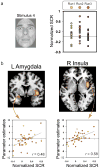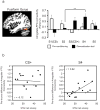Neurobehavioral mechanisms of human fear generalization
- PMID: 21256233
- PMCID: PMC3062636
- DOI: 10.1016/j.neuroimage.2011.01.041
Neurobehavioral mechanisms of human fear generalization
Abstract
While much research has elucidated the neurobiology of fear learning, the neural systems supporting the generalization of learned fear are unknown. Using functional magnetic resonance imaging (fMRI), we show that regions involved in the acquisition of fear support the generalization of fear to stimuli that are similar to a learned threat, but vary in fear intensity value. Behaviorally, subjects retrospectively misidentified a learned threat as a more intense stimulus and expressed greater skin conductance responses (SCR) to generalized stimuli of high intensity. Brain activity related to intensity-based fear generalization was observed in the striatum, insula, thalamus/periacqueductal gray, and subgenual cingulate cortex. The psychophysiological expression of generalized fear correlated with amygdala activity, and connectivity between the amygdala and extrastriate visual cortex was correlated with individual differences in trait anxiety. These findings reveal the brain regions and functional networks involved in flexibly responding to stimuli that resemble a learned threat. These regions may comprise an intensity-based fear generalization circuit that underlies retrospective biases in threat value estimation and overgeneralization of fear in anxiety disorders.
Copyright © 2011 Elsevier Inc. All rights reserved.
Figures





References
-
- Ahs F, Pissiota A, Michelgard A, Frans O, Furmark T, Appel L, Fredrikson M. Disentangling the web of fear: Amygdala reactivity and functional connectivity in spider and snake phobia. Psychiatry Research-Neuroimaging. 2009;172:103–108. - PubMed
-
- Amaral DG, Behniea H, Kelly JL. Topographic organization of projections from the amygdala to the visual cortex in the macaque monkey. Neuroscience. 2003;118:1099–1120. - PubMed
-
- Armony JL, Dolan RJ. Modulation of spatial attention by fear-conditioned stimuli: an event-related fMRI study. Neuropsychologia. 2002;40:817–826. - PubMed
-
- Armony JL, Servan-Schreiber D, Romanski LM, Cohen JD, LeDoux JE. Stimulus generalization of fear responses: Effects of auditory cortex lesions in a computational model and in rats. Cerebral Cortex. 1997;7:157–165. - PubMed
Publication types
MeSH terms
Grants and funding
LinkOut - more resources
Full Text Sources
Medical

